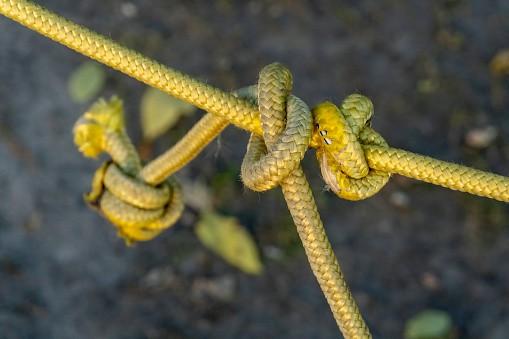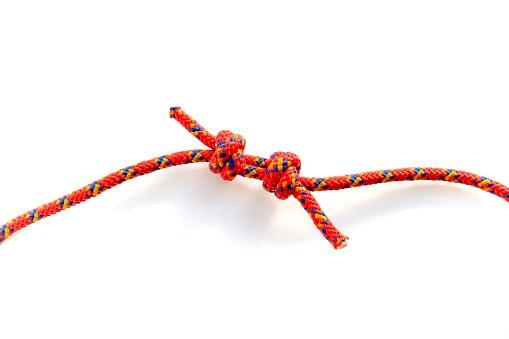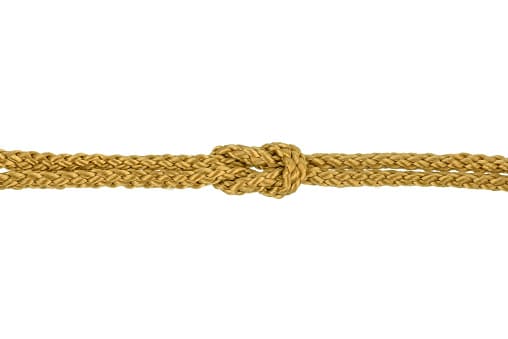Paracord, also known as the parachute cord, is a nylon rope that was originally used in parachutes during WWII but, because of its smooth texture and elasticity, survivalists have considered this as their general purpose cord. Moreover, knowing how to tie paracord knots is a very useful skill that you can use not only in survival but also, in other aspects of life. Which will lead us to the next section where you will learn how to tie the most common knots each survivalist should know.

1. Clove Hitch Knot
The clove hitch is a knot that is useful in securing things that are upright such as poles and trees.
- Put one of the cords around the pole to form an “X.”
- Bring the shorter end of the cord around the pole again.
- Then slip it under the “X” that was formed previously and pull tight.
2. Square Knot

Also known as a reef knot, this is often used to tie two cords that are of the same thickness so, this should not be used for cords that have different sizes.
- Get two ropes and place them on a flat surface. Place, one on the left and the other on the right.
- Take the end of the right cord and slip it under the left cord to make a twist.
- Now, the right cord becomes the left and vice versa.
- Get the end of the new left cord and slip it under the right cord and make another twist
- Finally, pull the ends to tighten.
3. Figure Eight Knot
This is a knot that every survivalist should know because this is one of the strongest knots around. Because of the secure knot it creates, it is famous among mountain climbers as well.
- Using a cord in a vertical position, mark the top end as the “anchor” and the bottom as the “tail.”
- Take the tail and slip it under the rope to form an “8.”
- Insert the tail end and insert it into the bottom circle of the “8” you have created.
- Create another figure “8” by tracing the first “8” with the use of the tail end.
- Pull the strands to tighten the knot.
4. Two Half Hitches Knot

The two-half hitches knot can be used to tie nearly everything that’s why it is considered an all-purpose knot. Similar to the square knot, this can also be used to tie two ropes together.
- Take the end of the rope and put it around the object to make an overhand knot.
- Repeat the same process to make another half hitch and then pull to tighten.
5. The Bowline

The bowline knot is one of the most popular and simplest paracord knots, as it only consists of a single overhand knot tied in the bight. First devised as a noose for hunting or warfare, you can use this tie to create fixed loops at the end of a line.
What’s special about it?
Bowline knot may be used as an alternative to the figure-eight loop because:
1) It does not jam; and
2) It is easier to untie after the load is applied (although there are other alternatives that do not present these problems). It has many uses such as forming fixed loops at the end of a line, for instance, setting up tent guy lines.
6. The Slip Knot
A slip knot is a type of knot that can be easily undone by pulling a single loop of the running end, unlike most knots which usually require two loops to be pulled in order to untie them.
In other words, it can be slipped off the object once it is tightened, but without any slippage occurring while being tied. Because of this characteristic, its primary use is to temporarily attach one object to another for purposes such as quick release from a branch when climbing or moving around in trees.
What’s special about it?
The slip knot is commonly used in boating and sailing for operations such as tying a boat alongside a pier or bringing a rope aboard a ship. It is also frequently used when abseiling or rappelling since it can easily be opened to release the tension of the rope around one’s body after reaching the ground.
7. The Double Fisherman’s Knot

A double fisherman’s knot is a bend typically used in climbing and caving, where two ropes are tied together for convenience. It consists of an overhand knot on a bight with both ends tied in the opposite direction with an additional twist so that their bitter ends form another overhand knot at opposing angles.
This particular configuration resists not only loosening due to this additional binding component but also slipping when loaded along its axis.
What’s special about it?
The double fisherman’s knot is useful when connecting two ropes together because if one rope is cut, the other will be held fast. It is also typically used in applications like climbing or caving because it can easily be tied with one hand.
8. Butcher’s Knot
A butcher knot is a binding knot, which in nautical usage means it may be tied without access to either end of the line. The butcher’s knot has two advantageous properties: when finished it does not slip when pulled from any direction and when pulled suddenly it does not bind or catch on itself.
It is thus well suited for tying heavy loads that are likely to cause slippage in knots having only one structure type (e.g., square, half-hitch) when pulled suddenly at their free ends. Its primary disadvantages are that it is relatively hard to tie and that its symmetrical structure means the direction of strain on the knot is always parallel to either the standing end of the working end.
What’s special about it?
Butcher’s knots are used most often when: the working end has been threaded through a complicated series of rings and blocks, such as in a block and tackle; or when there is a great risk of the knot being caught by chafing gear such as in heavy ropework. It can also be identified with metal wire rope where it serves as both a stopper knot and bend (joining).
9. Constrictor Knot
A constrictor knot is used for binding objects together tightly or closing off a loop in the middle of a cord. It is used as a stopper knot, for example at the end of a rope, to prevent it from unraveling. When tied around other ropes such as climbing ropes it can add security in case one rope fails.
What’s special about it?
Its main use is that when cinched tight around an object it grips and constricts. Constriction occurs mainly by way of friction: if the running end (working end) is pulled through and removed, and then pressure is applied to the standing part so that both ends are pulled evenly towards each other, this will have the effect of tightening up the knot even more.
10. Taut Line Hitch

The taut-line hitch is a quick and easy method of tightening or loosening a tent guyline by adjusting the tension using an implement such as a stick. It slides easily when slack but grips tightly under load, making it useful for things like securing guy ropes on tents or tarps without significantly reducing the length of the line. At the same time, it remains easy to undo, unlike some other hitches which are difficult to untie once they have been tightened around an object.
What’s special about it?
The taut-line hitch is a knot that grips under tension and slides to adjust the rope while keeping it at a constant length. This makes it easy to tighten or loosen a guyline for example on a tent, without significantly reducing the length of the line.
Along with these paracord bracelets, you can try lanyard knot, snake knot, and cobra knot. The materials needed are the same (e.g. sharp knife) and you can try these paracord projects in certain situations. For example, in a lanyard knot, first bend the paracord so that your two middle fingers can hold in the loop end.
Make another loop at the right end and make sure it goes over the left end as you place it in your palm. Hold the left end after the first wrap, push the end underneath the right end, and then feed the left side through the right loop resting in your hand-palm on the opposite end.
Conclusion
There are other knots that are useful in survival situations but these are the four that each survivalist should know. So, if you want to be ready at all times, the knowledge of these paracord knots will definitely come in handy.


